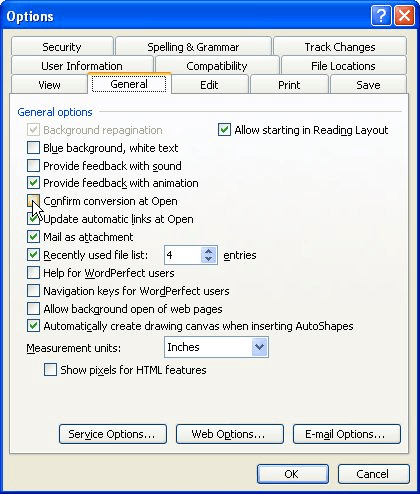Please Note: This article is written for users of the following Microsoft Word versions: 97, 2000, 2002, and 2003. If you are using a later version (Word 2007 or later), this tip may not work for you. For a version of this tip written specifically for later versions of Word, click here: Turning Off HTML Conversions.
Written by Allen Wyatt (last updated June 20, 2020)
This tip applies to Word 97, 2000, 2002, and 2003
Word includes a feature that allows you to open HTML documents and have them appear on your screen as formatted text. For some people this is great, while others see it as a big bother. If you don't want your HTML documents formatted by Word, but instead want them opened as straight text, you have two general ways you can do this.
First, you can remove the HTML file filter used by Word. This is done by running the Word Setup program and then making sure the HTML filter is removed from the system. (You do this by making sure the option is explicitly NOT selected in the Setup program.)
The other way is less drastic, but can be just as helpful. Follow these steps:

Figure 1. The General tab of the Options dialog box.
Now, whenever you open a document with an HTML (or HTM) extension, Word displays the Convert File dialog box. Here you are being asked how you want Word to treat the file you are opening. The HTML Document option is selected, since Word detected the file contained HTML code. You can select the Text Only option, and then Word will treat the file as plain text, without doing any formatting.
You should note that the procedure just described only works if you use the Open dialog box to open your file. If you later use the MRU file list to open the file, or the Documents list from Windows, then Word doesn't ask you how it should do the file conversion—it straightaway opens the file as a formatted HTML document. If you do quite a bit of this type of file opening, then your best option is to remove the HTML file filter as first described in this tip.
WordTips is your source for cost-effective Microsoft Word training. (Microsoft Word is the most popular word processing software in the world.) This tip (5413) applies to Microsoft Word 97, 2000, 2002, and 2003. You can find a version of this tip for the ribbon interface of Word (Word 2007 and later) here: Turning Off HTML Conversions.

The First and Last Word on Word! Bestselling For Dummies author Dan Gookin puts his usual fun and friendly candor back to work to show you how to navigate Word 2019. Spend more time working and less time trying to figure it all out! Check out Word 2019 For Dummies today!
Open a file that isn't a Word document and Word will still try to convert it to a Word document. If you want Word to let ...
Discover MoreWant to control the name and location of your document backup? Here are some ideas that may help.
Discover MoreAfter merging the information from a data source into a document, you may decide that you only want to open the merge ...
Discover MoreFREE SERVICE: Get tips like this every week in WordTips, a free productivity newsletter. Enter your address and click "Subscribe."
There are currently no comments for this tip. (Be the first to leave your comment—just use the simple form above!)
Got a version of Word that uses the menu interface (Word 97, Word 2000, Word 2002, or Word 2003)? This site is for you! If you use a later version of Word, visit our WordTips site focusing on the ribbon interface.
Visit the WordTips channel on YouTube
FREE SERVICE: Get tips like this every week in WordTips, a free productivity newsletter. Enter your address and click "Subscribe."
Copyright © 2026 Sharon Parq Associates, Inc.
Comments